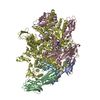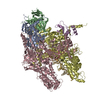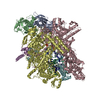[English] 日本語
 Yorodumi
Yorodumi- PDB-6swe: IC2 head of cryo-EM structure of a full archaeal ribosomal transl... -
+ Open data
Open data
- Basic information
Basic information
| Entry | Database: PDB / ID: 6swe | |||||||||||||||||||||||||||||||||||||||||||||||||||
|---|---|---|---|---|---|---|---|---|---|---|---|---|---|---|---|---|---|---|---|---|---|---|---|---|---|---|---|---|---|---|---|---|---|---|---|---|---|---|---|---|---|---|---|---|---|---|---|---|---|---|---|---|
| Title | IC2 head of cryo-EM structure of a full archaeal ribosomal translation initiation complex devoid of aIF1 in P. abyssi | |||||||||||||||||||||||||||||||||||||||||||||||||||
 Components Components |
| |||||||||||||||||||||||||||||||||||||||||||||||||||
 Keywords Keywords | RIBOSOME / Translation initiation / cryo-EM / tRNA / evolution / archaea / rRNA modifications | |||||||||||||||||||||||||||||||||||||||||||||||||||
| Function / homology |  Function and homology information Function and homology informationribonuclease P activity / tRNA 5'-leader removal / translation initiation factor activity / maturation of SSU-rRNA from tricistronic rRNA transcript (SSU-rRNA, 5.8S rRNA, LSU-rRNA) / maturation of SSU-rRNA / ribosome biogenesis / ribosomal small subunit assembly / small ribosomal subunit / cytosolic small ribosomal subunit / cytoplasmic translation ...ribonuclease P activity / tRNA 5'-leader removal / translation initiation factor activity / maturation of SSU-rRNA from tricistronic rRNA transcript (SSU-rRNA, 5.8S rRNA, LSU-rRNA) / maturation of SSU-rRNA / ribosome biogenesis / ribosomal small subunit assembly / small ribosomal subunit / cytosolic small ribosomal subunit / cytoplasmic translation / tRNA binding / rRNA binding / structural constituent of ribosome / ribosome / translation / ribonucleoprotein complex / RNA binding / zinc ion binding / cytosol / cytoplasm Similarity search - Function | |||||||||||||||||||||||||||||||||||||||||||||||||||
| Biological species |    Pyrococcus abyssi (archaea) Pyrococcus abyssi (archaea)  Pyrococcus abyssi GE5 (archaea) Pyrococcus abyssi GE5 (archaea) | |||||||||||||||||||||||||||||||||||||||||||||||||||
| Method | ELECTRON MICROSCOPY / single particle reconstruction / cryo EM / Resolution: 3.1 Å | |||||||||||||||||||||||||||||||||||||||||||||||||||
 Authors Authors | Coureux, P.-D. / Mechulam, Y. / Schmitt, E. | |||||||||||||||||||||||||||||||||||||||||||||||||||
| Funding support |  France, 1items France, 1items
| |||||||||||||||||||||||||||||||||||||||||||||||||||
 Citation Citation |  Journal: Commun Biol / Year: 2020 Journal: Commun Biol / Year: 2020Title: Cryo-EM study of an archaeal 30S initiation complex gives insights into evolution of translation initiation. Authors: Pierre-Damien Coureux / Christine Lazennec-Schurdevin / Sophie Bourcier / Yves Mechulam / Emmanuelle Schmitt /  Abstract: Archaeal translation initiation occurs within a macromolecular complex containing the small ribosomal subunit (30S) bound to mRNA, initiation factors aIF1, aIF1A and the ternary complex aIF2:GDPNP: ...Archaeal translation initiation occurs within a macromolecular complex containing the small ribosomal subunit (30S) bound to mRNA, initiation factors aIF1, aIF1A and the ternary complex aIF2:GDPNP:Met-tRNA. Here, we determine the cryo-EM structure of a 30S:mRNA:aIF1A:aIF2:GTP:Met-tRNA complex from Pyrococcus abyssi at 3.2 Å resolution. It highlights archaeal features in ribosomal proteins and rRNA modifications. We find an aS21 protein, at the location of eS21 in eukaryotic ribosomes. Moreover, we identify an N-terminal extension of archaeal eL41 contacting the P site. We characterize 34 N-acetylcytidines distributed throughout 16S rRNA, likely contributing to hyperthermostability. Without aIF1, the 30S head is stabilized and initiator tRNA is tightly bound to the P site. A network of interactions involving tRNA, mRNA, rRNA modified nucleotides and C-terminal tails of uS9, uS13 and uS19 is observed. Universal features and domain-specific idiosyncrasies of translation initiation are discussed in light of ribosomal structures from representatives of each domain of life. | |||||||||||||||||||||||||||||||||||||||||||||||||||
| History |
|
- Structure visualization
Structure visualization
| Movie |
 Movie viewer Movie viewer |
|---|---|
| Structure viewer | Molecule:  Molmil Molmil Jmol/JSmol Jmol/JSmol |
- Downloads & links
Downloads & links
- Download
Download
| PDBx/mmCIF format |  6swe.cif.gz 6swe.cif.gz | 523.2 KB | Display |  PDBx/mmCIF format PDBx/mmCIF format |
|---|---|---|---|---|
| PDB format |  pdb6swe.ent.gz pdb6swe.ent.gz | 404.8 KB | Display |  PDB format PDB format |
| PDBx/mmJSON format |  6swe.json.gz 6swe.json.gz | Tree view |  PDBx/mmJSON format PDBx/mmJSON format | |
| Others |  Other downloads Other downloads |
-Validation report
| Summary document |  6swe_validation.pdf.gz 6swe_validation.pdf.gz | 1.3 MB | Display |  wwPDB validaton report wwPDB validaton report |
|---|---|---|---|---|
| Full document |  6swe_full_validation.pdf.gz 6swe_full_validation.pdf.gz | 1.4 MB | Display | |
| Data in XML |  6swe_validation.xml.gz 6swe_validation.xml.gz | 65.8 KB | Display | |
| Data in CIF |  6swe_validation.cif.gz 6swe_validation.cif.gz | 107.8 KB | Display | |
| Arichive directory |  https://data.pdbj.org/pub/pdb/validation_reports/sw/6swe https://data.pdbj.org/pub/pdb/validation_reports/sw/6swe ftp://data.pdbj.org/pub/pdb/validation_reports/sw/6swe ftp://data.pdbj.org/pub/pdb/validation_reports/sw/6swe | HTTPS FTP |
-Related structure data
| Related structure data |  10324MC  6sw9C  6swcC  6swdC M: map data used to model this data C: citing same article ( |
|---|---|
| Similar structure data |
- Links
Links
- Assembly
Assembly
| Deposited unit | 
|
|---|---|
| 1 |
|
- Components
Components
-RNA chain , 2 types, 2 molecules 24
| #1: RNA chain | Mass: 152069.453 Da / Num. of mol.: 1 / Source method: isolated from a natural source / Source: (natural)   Pyrococcus abyssi GE5 (archaea) Pyrococcus abyssi GE5 (archaea) |
|---|---|
| #14: RNA chain | Mass: 5761.509 Da / Num. of mol.: 1 Source method: isolated from a genetically manipulated source Source: (gene. exp.)   |
-30S ribosomal protein ... , 11 types, 11 molecules HKLOPSTUXYZ
| #2: Protein | Mass: 24662.818 Da / Num. of mol.: 1 / Source method: isolated from a natural source Source: (natural)   Pyrococcus abyssi (strain GE5 / Orsay) (archaea) Pyrococcus abyssi (strain GE5 / Orsay) (archaea)Strain: GE5 / Orsay / References: UniProt: Q9V109 |
|---|---|
| #3: Protein | Mass: 15293.867 Da / Num. of mol.: 1 / Source method: isolated from a natural source Source: (natural)   Pyrococcus abyssi (strain GE5 / Orsay) (archaea) Pyrococcus abyssi (strain GE5 / Orsay) (archaea)Strain: GE5 / Orsay / References: UniProt: Q9V195 |
| #4: Protein | Mass: 11795.769 Da / Num. of mol.: 1 / Source method: isolated from a natural source Source: (natural)   Pyrococcus abyssi (strain GE5 / Orsay) (archaea) Pyrococcus abyssi (strain GE5 / Orsay) (archaea)Strain: GE5 / Orsay / References: UniProt: Q9V0V6 |
| #5: Protein | Mass: 16992.912 Da / Num. of mol.: 1 / Source method: isolated from a natural source Source: (natural)   Pyrococcus abyssi (strain GE5 / Orsay) (archaea) Pyrococcus abyssi (strain GE5 / Orsay) (archaea)Strain: GE5 / Orsay / References: UniProt: Q9V1A0 |
| #6: Protein | Mass: 6644.064 Da / Num. of mol.: 1 / Source method: isolated from a natural source Source: (natural)   Pyrococcus abyssi (strain GE5 / Orsay) (archaea) Pyrococcus abyssi (strain GE5 / Orsay) (archaea)Strain: GE5 / Orsay / References: UniProt: P62012 |
| #7: Protein | Mass: 8059.528 Da / Num. of mol.: 1 / Source method: isolated from a natural source Source: (natural)   Pyrococcus abyssi (strain GE5 / Orsay) (archaea) Pyrococcus abyssi (strain GE5 / Orsay) (archaea)Strain: GE5 / Orsay / References: UniProt: Q9V0G0 |
| #8: Protein | Mass: 15307.319 Da / Num. of mol.: 1 / Source method: isolated from a natural source Source: (natural)   Pyrococcus abyssi (strain GE5 / Orsay) (archaea) Pyrococcus abyssi (strain GE5 / Orsay) (archaea)Strain: GE5 / Orsay / References: UniProt: Q9V1T9 |
| #9: Protein | Mass: 17422.250 Da / Num. of mol.: 1 / Source method: isolated from a natural source Source: (natural)   Pyrococcus abyssi (strain GE5 / Orsay) (archaea) Pyrococcus abyssi (strain GE5 / Orsay) (archaea)Strain: GE5 / Orsay / References: UniProt: Q9V0G8 |
| #10: Protein | Mass: 8102.305 Da / Num. of mol.: 1 / Source method: isolated from a natural source Source: (natural)   Pyrococcus abyssi (strain GE5 / Orsay) (archaea) Pyrococcus abyssi (strain GE5 / Orsay) (archaea)Strain: GE5 / Orsay / References: UniProt: P61029 |
| #11: Protein | Mass: 5992.168 Da / Num. of mol.: 1 / Source method: isolated from a natural source Source: (natural)   Pyrococcus abyssi (strain GE5 / Orsay) (archaea) Pyrococcus abyssi (strain GE5 / Orsay) (archaea)Strain: GE5 / Orsay / References: UniProt: P61238 |
| #12: Protein | Mass: 23472.309 Da / Num. of mol.: 1 / Source method: isolated from a natural source Source: (natural)   Pyrococcus abyssi (strain GE5 / Orsay) (archaea) Pyrococcus abyssi (strain GE5 / Orsay) (archaea)Strain: GE5 / Orsay / References: UniProt: Q9V1U1 |
-Protein , 2 types, 2 molecules 36
| #13: Protein | Mass: 13442.678 Da / Num. of mol.: 1 / Source method: isolated from a natural source Source: (natural)   Pyrococcus abyssi (strain GE5 / Orsay) (archaea) Pyrococcus abyssi (strain GE5 / Orsay) (archaea)Strain: GE5 / Orsay / References: UniProt: P62008 |
|---|---|
| #15: Protein | Mass: 13078.265 Da / Num. of mol.: 1 Source method: isolated from a genetically manipulated source Source: (gene. exp.)   Pyrococcus abyssi (strain GE5 / Orsay) (archaea) Pyrococcus abyssi (strain GE5 / Orsay) (archaea)Strain: GE5 / Orsay / Gene: eIF1A, aif1A, PYRAB05910, PAB2441 / Production host:  |
-Non-polymers , 3 types, 27 molecules 




| #16: Chemical | ChemComp-MG / #17: Chemical | ChemComp-ZN / | #18: Water | ChemComp-HOH / | |
|---|
-Details
| Has ligand of interest | N |
|---|---|
| Has protein modification | Y |
-Experimental details
-Experiment
| Experiment | Method: ELECTRON MICROSCOPY |
|---|---|
| EM experiment | Aggregation state: PARTICLE / 3D reconstruction method: single particle reconstruction |
- Sample preparation
Sample preparation
| Component |
| ||||||||||||||||||||||||||||||
|---|---|---|---|---|---|---|---|---|---|---|---|---|---|---|---|---|---|---|---|---|---|---|---|---|---|---|---|---|---|---|---|
| Molecular weight | Value: 1.05 MDa / Experimental value: NO | ||||||||||||||||||||||||||||||
| Source (natural) |
| ||||||||||||||||||||||||||||||
| Source (recombinant) |
| ||||||||||||||||||||||||||||||
| Buffer solution | pH: 6.7 | ||||||||||||||||||||||||||||||
| Specimen | Embedding applied: NO / Shadowing applied: NO / Staining applied: NO / Vitrification applied: YES | ||||||||||||||||||||||||||||||
| Vitrification | Cryogen name: ETHANE |
- Electron microscopy imaging
Electron microscopy imaging
| Experimental equipment |  Model: Titan Krios / Image courtesy: FEI Company |
|---|---|
| Microscopy | Model: FEI TITAN KRIOS |
| Electron gun | Electron source:  FIELD EMISSION GUN / Accelerating voltage: 300 kV / Illumination mode: FLOOD BEAM FIELD EMISSION GUN / Accelerating voltage: 300 kV / Illumination mode: FLOOD BEAM |
| Electron lens | Mode: BRIGHT FIELD |
| Image recording | Electron dose: 2 e/Å2 / Film or detector model: GATAN K2 SUMMIT (4k x 4k) |
- Processing
Processing
| Software | Name: PHENIX / Version: 1.15.2_3472: / Classification: refinement | ||||||||||||||||||||||||
|---|---|---|---|---|---|---|---|---|---|---|---|---|---|---|---|---|---|---|---|---|---|---|---|---|---|
| EM software | Name: PHENIX / Category: model refinement | ||||||||||||||||||||||||
| CTF correction | Type: PHASE FLIPPING AND AMPLITUDE CORRECTION | ||||||||||||||||||||||||
| 3D reconstruction | Resolution: 3.1 Å / Resolution method: FSC 0.143 CUT-OFF / Num. of particles: 142000 / Symmetry type: POINT | ||||||||||||||||||||||||
| Refine LS restraints |
|
 Movie
Movie Controller
Controller













 PDBj
PDBj































